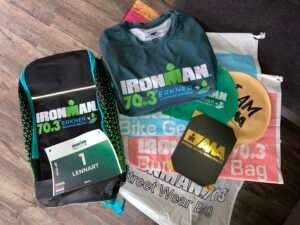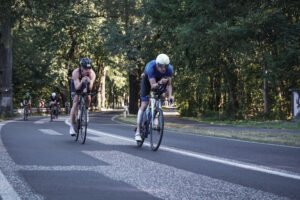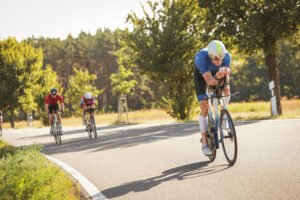In September 2022, after recovering from my shoulder fracture, I competed in the Ironman 70.3 Erkner triathlon race. Erkner, located just southeast of the German capital Berlin, is about 700 kilometers drive from my home so quite easy to get there by car. In 2022, I had a pretty good race with my best swim time ever (32 minutes), fast bike split, and a quite ok half marathon run of 1:34. Now in 2024, I’m back in Erkner! Will I be able to perform better?
 The swim and run courses are still the same, but the bike course has been changed to a 2-loop course. Considering the number of athletes, I didn’t know beforehand if that was going to work out well or if it would become a disaster for drafting and other annoying problems.
The swim and run courses are still the same, but the bike course has been changed to a 2-loop course. Considering the number of athletes, I didn’t know beforehand if that was going to work out well or if it would become a disaster for drafting and other annoying problems.
I arrived at my accommodation a few kilometers outside Erkner on Monday before the race. A spacious apartment and quiet area without traffic noise. Just an occasional airplane from the nearby airport. In the week before the race, I rode the bike course a few times, swam in the lake a couple of times, and did some runs in the area. The weather was heavily affected by the horrendous storm that created a lot of damage and flooding in eastern and central Europe. The temperature in Erkner was low and often raining. The water temperature of the lake wasn’t very high either; about 17-18 degrees on my Garmin watch. Not the conditions I enjoy or perform well with! Give me 25 degrees Celsius air temperature, 20 degrees water temperature, and sunshine and I’m happy!
On Friday we could register and receive all the race details/numbers/transition bags/etc. Since I was one of the first in the queue, and happened to be the only one with a valid national triathlon license (others had to buy a one-day license which took time) I was given the race number ‘1’…. Well, expectations were set very high by Ironman Erkner!
Saturday the race briefing and in the late afternoon the bike check-in. During the race briefing, it was mentioned that there is a 1.5-kilometer section of no-overtaking/no-aero but for the rest no real difficulties.
 Race Day
Race Day
My alarm went off on Sunday early morning before dawn. Breakfast, coffee, nutrition/wetsuit/shoes in the bag, and the car to Erkner. In 2022, I found a nearby parking lot off the main road and I used the same parking this year. From the transition zone, the music was going through the speakers already and many athletes were busy preparing their bikes and transition bags.
My Ku Cycle TF1 triathlon bike was race-ready, just the two nutrition bottles (one with NutrID Kerosene and one with water), pumping up the tires, and clicking in my bike shoes. My helmet and race number were already in my Bike transition bag during check-in on Saturday. Running shoes in the Run transition bag together with the flex bidon of NutrID Kerosene RS+, my sunglasses, and cap.
Due to the cold temperature of only 11 degrees of the air and 16 degrees of the water, the swim course was shortened from 1900 to 1500 meters and the rolling start was delayed to 08:05 hrs. It felt a lot colder than the days before…
 Swim
Swim
The rolling start was smooth and within a few minutes, I was in the water. As usual, it was a bit chaotic at the start but I managed to stay the outside of the mass until I came across a few breaststroke swimmers in front of me. At the same time or maybe these swimmers were the reason, I had a little cold shock and had to reset my focus which took a few seconds. Luckily I could continue freestyle swimming quickly and slowly came back into my pace. The cold water temperatures didn’t make it any easier and certainly did cost me some energy.
After 26m19s I came out of the water with an average swim pace of 1:45/100m. Certainly not a great time but considering the conditions it wasn’t even too bad. This ranked me 17 / 149 in my AG. The AG winner completed the swim 3 minutes faster.
Bike
 A short run to the transition zone, taking off the wetsuit, and trying to put on a slim-fit bike jacket… My wet arms wouldn’t go through the sleeves (a problem I had in a previous race as well) and I decided to continue without the jacket. Helmet on and run to the bike. Since I had race number ‘1’ my bike was racked closest to the bike exit. Once crossed the bike mount line, got on the bike, and off I was for the 90-kilometer bike ride.
A short run to the transition zone, taking off the wetsuit, and trying to put on a slim-fit bike jacket… My wet arms wouldn’t go through the sleeves (a problem I had in a previous race as well) and I decided to continue without the jacket. Helmet on and run to the bike. Since I had race number ‘1’ my bike was racked closest to the bike exit. Once crossed the bike mount line, got on the bike, and off I was for the 90-kilometer bike ride.
During the first section of the ride, I was able to push hard, make some good speed, and overtake many other athletes. Once arriving in the forest area, I started to feel the colder temperature. In the 5-kilometer back-and-forth section, I noticed several fast athletes drafting. Very annoying to see this is still happening. Luckily some were caught because the penalty tent at the end of the first loop was occupied! I think the drafting penalty should be increased to 10 or 15 minutes because of the huge advantage (higher speed, less energy) you can get after drafting for half an hour or longer.
 In the second loop, there were a lot more slower athletes on the course. Overtaking others feels good but also costs more focus. For the rest, I didn’t have many problems and congestion, except for the 1.5 km ‘no-overtake/no-aero’ section on the second loop. I got stuck behind a slow athlete. On the first loop, my average speed of this section was about 35 kmh, and on the second loop behind the slower athlete about 25 kmh… Nothing you can do about and certainly not worth getting agitated (like I heard some behind me).
In the second loop, there were a lot more slower athletes on the course. Overtaking others feels good but also costs more focus. For the rest, I didn’t have many problems and congestion, except for the 1.5 km ‘no-overtake/no-aero’ section on the second loop. I got stuck behind a slow athlete. On the first loop, my average speed of this section was about 35 kmh, and on the second loop behind the slower athlete about 25 kmh… Nothing you can do about and certainly not worth getting agitated (like I heard some behind me).
Unfortunately, I started to feel the cold of the forests during the second loop which slowly reduced my energy level. I was taking my nutrition as planned, 100 ml of NutrID Kerosene every half an hour and washed away with water (2 bottle system), but the power was a lot lower.
The first bike loop took me 1h05m and the second loop 1h08m so not even too bad of a decline. I came back in the transition zone after 2h18m15s, average speed of about 38.4 kmh, which ranked me 11 / 149. This was 7.5 minutes slower than the AG winner.
 Run
Run
Back in the transition zone, I quickly changed to my running gear. Ready for the half marathon to complete the race.
Unfortunately, quickly after starting the run, I felt it was going to be a difficult one… The half marathon course was a 4-loop and every loop was getting more and more difficult.
On the first loop, I was hoping to get back into a normal rhythm (unsuccessfully), the second loop was painful (but still pushing for a ‘decent’ time), the third loop was horrible with some short sections of walking, and the fourth loop was like hell with some walking and stopping… Unfortunately, I couldn’t make myself drink my NutrID Kerosene RS+ nutrition (flex bottle) and I only drank the small cola cups at both aid stations on each loop.
I knew before the start of the race that my run condition and run pace weren’t up to speed (pun intended) and would be the challenge of the day. Well, it was! In the end, I completed the half marathon in 1h48m07s, average run speed of 5:08/1km, ranking 64 / 149… This was about 15-20 minutes slower than normal for me in an Ironman 70.3 race. The AG winner was 23 minutes faster. Even though I wasn’t in top-fit condition, this wasn’t the run time I was expecting or hoping for…
 Finish
Finish
I completed the Ironman 70.3 Erkner in 4h39m18s, which ranked me 31 out of 149 in my age group.
This race was tough mainly because of the cold temperatures and horrible run. The good thing is that I finished and didn’t give up.
After crossing the finish line, I wasn’t able to drink or eat anything for some time. My body was drained completely. Maybe after 20-30 minutes, I was finally able to eat some little pieces and drink some water and cola.
Conclusion
 I look back to this race with some mixed feelings. In one way I’m pleased with my good performance on the Ku Cycle bike and my preparation for the race in regards to nutrition but in the other way, I’m annoyed that the cold water influenced my swim and probably influenced my further race by draining my energy level. Of course, my current run condition didn’t make the half marathon any easier. Over the winter period, I haven’t trained as much as I’d like to because I’ve been working a lot until the end of June 2024. The last few projects were on vessels without good training facilities, unfortunately. Starting with a huge training backlog from the winter/spring period and ramping up the training from the end of June until mid-September (2.5 months) was tough and not long enough.
I look back to this race with some mixed feelings. In one way I’m pleased with my good performance on the Ku Cycle bike and my preparation for the race in regards to nutrition but in the other way, I’m annoyed that the cold water influenced my swim and probably influenced my further race by draining my energy level. Of course, my current run condition didn’t make the half marathon any easier. Over the winter period, I haven’t trained as much as I’d like to because I’ve been working a lot until the end of June 2024. The last few projects were on vessels without good training facilities, unfortunately. Starting with a huge training backlog from the winter/spring period and ramping up the training from the end of June until mid-September (2.5 months) was tough and not long enough.
Since a few weeks before the race, I’m getting advice from a food coach to improve my food/nutrition intake. Although I had only started a short while ago, I felt that the preparation for the race had been going a lot better. No massive pasta meals, dozens of pancakes, and many protein shakes but a balanced approach and concentrated around the training and adjusted to the intensity of the training. For me, the major change is that I have to stop my automatic pilot for eating! Highly recommend contacting Jaime Frias food coaching if you want to know more!
I’m unsure why I wasn’t able to drink the Nutrid Kerosene RS+ on the run. Could it be the intake of Kerosene on the bike was too much or I should have stopped drinking longer before coming back in transition (?), the cold temperatures affecting my body, or something else? After the race, my food coach advised me to check out another nutrition called Carborange. It’s composed entirely of natural products, vegan, and specifically developed for optimal stomach comfort. I’ve been testing it out for a few weeks and the feeling is good but during training, I had no issues with NutrID Kerosene either… Let’s see if it makes a difference in the next race!
Next Triathlon Race
The next triathlon race is on 20 October in Porec, Croatia. Just 5 weeks to recover, train hard, and taper the last week again. I hope I’ll be stronger and faster, and with a better finish result!
Hi Lennart!
I am doing the race this year and would really appreciate if you share with me the parking slot where you parked… I have to go by car and don’t know where to leave it…
Thank you!
Hi Ivan,
Both times I competed at Erkner, I parked in the Hans-Lebach Strasse. There is a parking lot but many people parked their car just along the street without issues. It isn’t far from the transition area.
Good luck with the race on Sunday!